DNA, or deoxyribonucleic acid, stands as one of the most fascinating molecules in the biological world. It serves as the fundamental building block for life, carrying the genetic instructions that dictate everything from eye color to disease susceptibility. This molecule not only defines our individual traits but also connects us to the vast tapestry of life on Earth, from simple bacteria to complex multicellular organisms.
In this comprehensive article, we’ll dive deep into the intricacies of DNA, exploring its structure, how it was discovered, its vital functions, and the groundbreaking applications that have transformed fields like medicine, forensics, and agriculture. We’ll draw on historical insights and scientific advancements to paint a complete picture, making complex concepts accessible through clear explanations and examples.
Table of Contents
Understanding DNA goes beyond textbook definitions; it’s about appreciating how this molecule orchestrates the symphony of life. Whether you’re a student, a curious reader, or someone interested in biotechnology, this guide will provide a thorough exploration, enriched with real-world examples and detailed breakdowns.
What is DNA? A Closer Look at the Molecule of Heredity
DNA is a long, chain-like molecule that stores and transmits genetic information from one generation to the next. It’s composed of smaller units called nucleotides, each consisting of a sugar molecule (deoxyribose), a phosphate group, and one of four nitrogenous bases: adenine (A), thymine (T), guanine (G), and cytosine (C). These bases are the alphabet of life, forming the code that instructs cells on how to build proteins and perform essential functions.
In most organisms, DNA resides in the cell’s nucleus, but it’s also found in organelles like mitochondria and, in plants, plastids. For instance, human cells contain about 3 billion base pairs in their nuclear DNA, coiled into 23 pairs of chromosomes. This genetic material isn’t just a static blueprint; it’s dynamic, constantly being read, copied, and repaired to ensure the organism’s survival.
Viruses, too, can carry DNA as their genetic material, though some use RNA instead. Take the herpes simplex virus, a common DNA virus that causes cold sores; it integrates its DNA into the host cell’s genome, allowing it to persist and reactivate later. This dual nature highlights DNA’s versatility across different life forms.

Key Components of DNA Nucleotides
- Sugar: Deoxyribose, which gives DNA its name.
- Phosphate: Forms the backbone, linking nucleotides together.
- Bases: Purines (A and G) and pyrimidines (C and T), which pair specifically.
Beyond the basics, DNA’s role extends to regulating gene expression, where environmental factors can influence which genes are turned on or off. For example, in response to stress, certain DNA segments might activate genes for protective proteins.
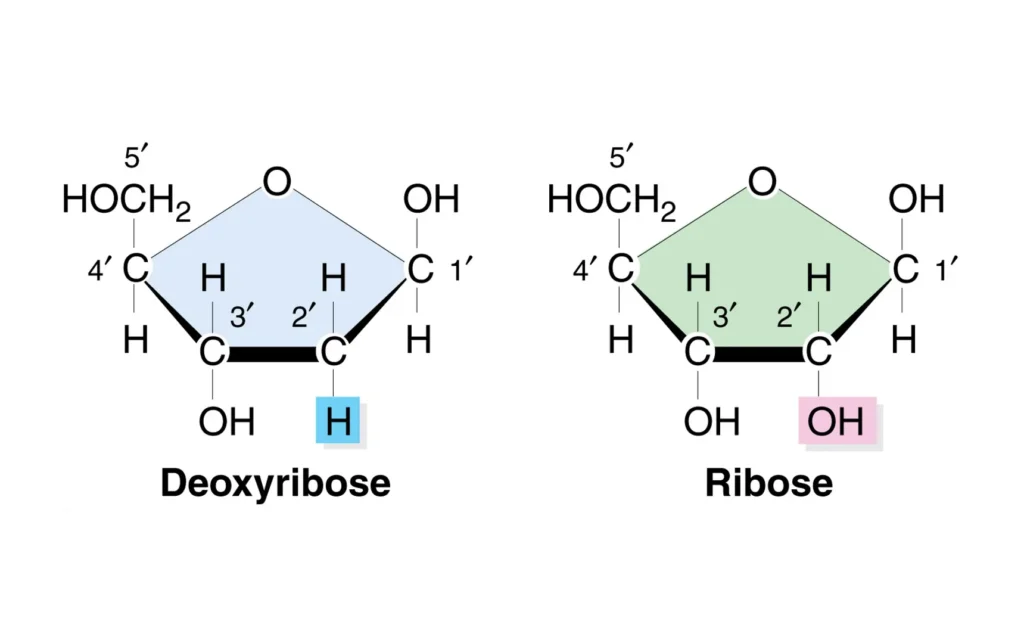
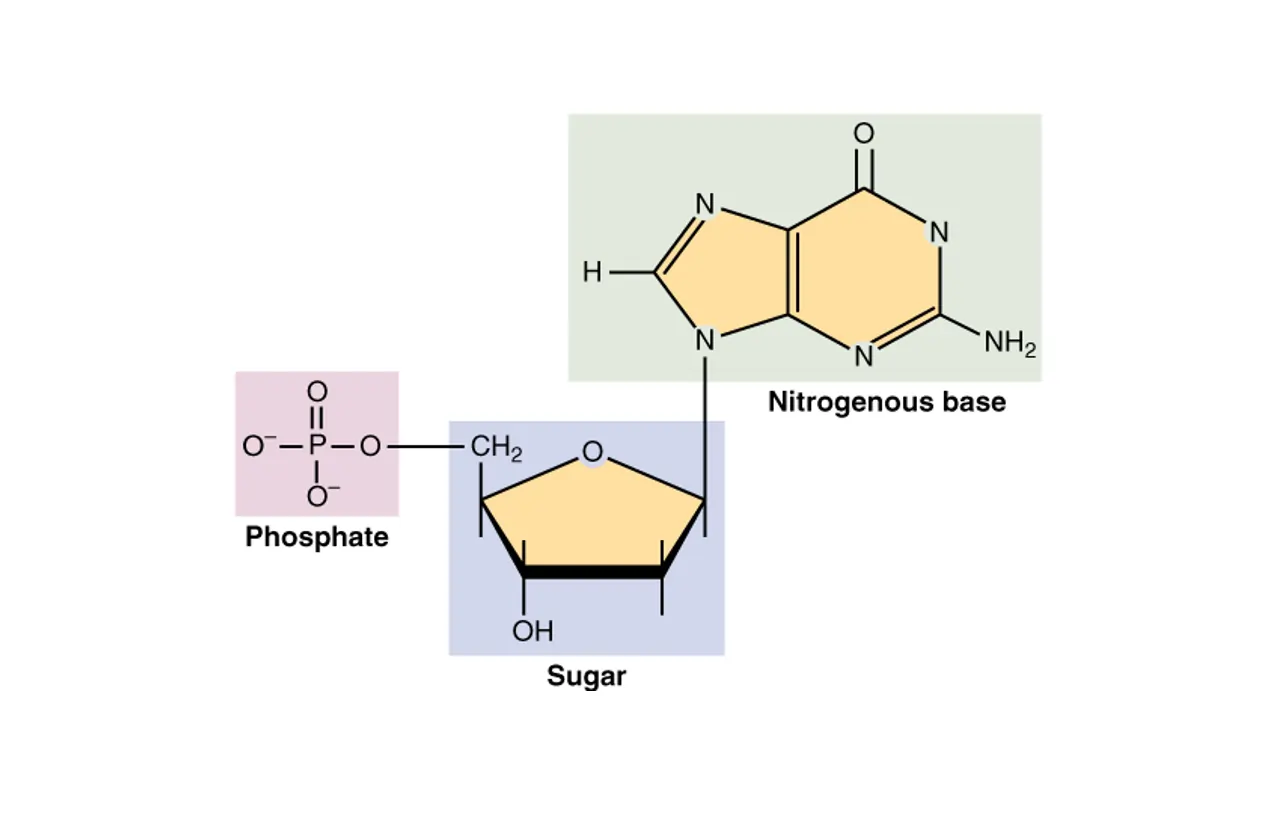
The Discovery of DNA: A Timeline of Scientific Breakthroughs
The journey to understanding DNA spans over a century, marked by pivotal discoveries from dedicated scientists. It began in 1869 when Swiss biologist Friedrich Miescher isolated a substance he called “nuclein” from white blood cells, later identified as DNA. This acidic material from cell nuclei was a mystery at the time, but it laid the groundwork for future research.
In the early 20th century, researchers like Phoebus Levene identified the basic components of DNA, including its sugar-phosphate backbone and bases. However, it wasn’t until the 1940s that DNA’s role as the genetic material was confirmed. Oswald Avery’s experiments in 1943 showed that DNA, not proteins, carried hereditary information in bacteria.
The iconic double-helix structure was unveiled in 1953 by James Watson and Francis Crick, based on X-ray diffraction data from Rosalind Franklin and Maurice Wilkins. Franklin’s famous “Photo 51” provided crucial evidence of the helical form. This model explained how DNA could replicate and store information efficiently.
- Milestones in DNA Discovery:
- 1869: Miescher discovers nuclein.
- 1909: Levene identifies nucleotides.
- 1933: Studies on sea urchin eggs reveal DNA’s role in development.
- 1943: Avery proves DNA is the genetic material.
- 1953: Watson and Crick propose the double helix.
Post-1953, advancements continued. In the 1970s, the development of DNA sequencing techniques by Frederick Sanger revolutionized genetics. Today, with CRISPR technology, we’re editing DNA with precision, building on these early foundations.
This history isn’t just about dates; it’s a story of collaboration and controversy. Franklin’s contributions, often underrecognized due to gender biases of the era, highlight the human element in science.
The Intricate Structure of DNA: From Nucleotides to Chromosomes
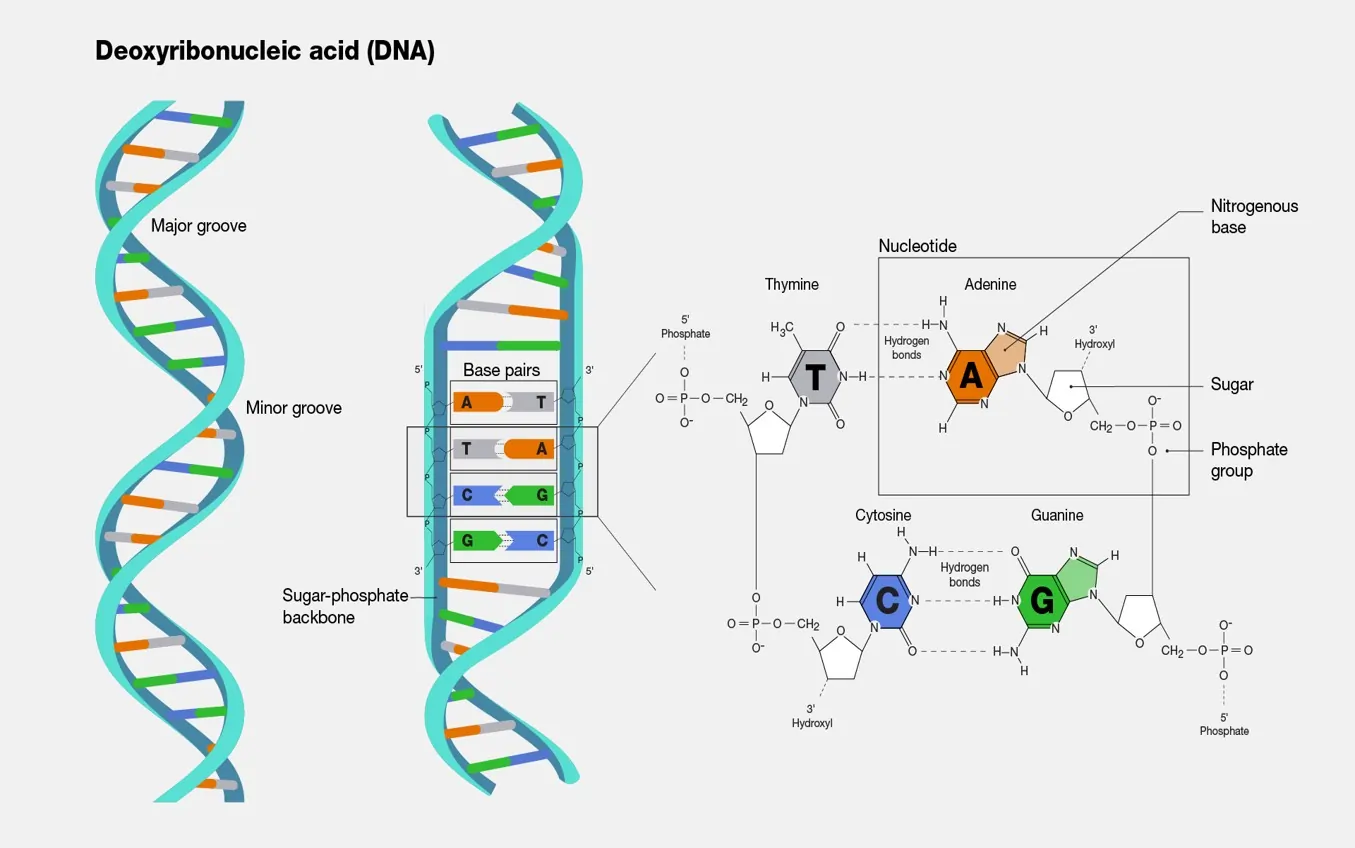
Visualize DNA as a twisted ladder: the sides are alternating sugar and phosphate molecules, while the rungs are paired nitrogenous bases. This double-helix structure, with its right-handed twist, allows for stability and easy unzipping during replication.
Each strand runs in opposite directions (antiparallel), with bases pairing via hydrogen bonds: A with T (two bonds) and C with G (three bonds). This complementary pairing ensures accurate copying. The helix completes a full turn every 10 base pairs, with a pitch of about 3.4 nanometers.
In eukaryotic cells, DNA wraps around histone proteins to form chromatin, which condenses into chromosomes during cell division. Humans have 46 chromosomes, each containing a single, long DNA molecule.
Consider the scale: if stretched out, the DNA in one human cell would reach about 2 meters long, yet it’s packed into a nucleus just 6 micrometers wide. This packaging is crucial for gene regulation.
| Component | Description | Role in Structure |
|---|---|---|
| Deoxyribose Sugar | Five-carbon sugar molecule | Forms the backbone with phosphates, providing structural support |
| Phosphate Group | Negatively charged group linking sugars | Creates the phosphodiester bonds, giving DNA its acidic nature |
| Adenine (A) | Purine base | Pairs with thymine via two hydrogen bonds |
| Thymine (T) | Pyrimidine base | Pairs with adenine, essential for base stacking |
| Guanine (G) | Purine base | Pairs with cytosine via three hydrogen bonds, stronger pairing |
| Cytosine (C) | Pyrimidine base | Pairs with guanine, involved in methylation for gene regulation |
This table illustrates how each part contributes to DNA’s overall architecture, ensuring both flexibility and rigidity.
Types of DNA: Exploring A-DNA, B-DNA, and Z-DNA Forms
DNA isn’t always in one fixed shape; it can adopt different conformations based on environmental conditions like humidity or salt concentration. The most common is B-DNA, the right-handed helix described by Watson and Crick, prevalent under normal physiological conditions.
A-DNA forms in dehydrated environments, also right-handed but shorter and wider, with a deeper major groove. It’s thought to protect DNA during stress, like desiccation, and is involved in protein binding.
Z-DNA, discovered by Alexander Rich and Andres Wang, is a left-handed helix with a zigzag backbone, often forming in regions with alternating purine-pyrimidine sequences. It may play roles in gene regulation and is linked to diseases like cancer when dysregulated.
These forms highlight DNA’s adaptability. For example, in lab settings, high salt concentrations favor Z-DNA, which could influence how genes are expressed.
- Biological Implications of DNA Types:
- B-DNA: Standard for transcription and replication in cells.
- A-DNA: Seen in RNA-DNA hybrids during transcription.
- Z-DNA: Potentially involved in relieving torsional stress during gene activity.
| DNA Type | Helix Direction | Base Pairs per Turn | Groove Characteristics | Conditions Favoring Formation | Biological Role |
|---|---|---|---|---|---|
| A-DNA | Right-handed | 11 | Deep minor groove, shallow major | Low humidity, dehydration | Protection during stress, protein interactions |
| B-DNA | Right-handed | 10.5 | Wide major groove, narrow minor | Normal physiological conditions | Primary form for genetic processes |
| Z-DNA | Left-handed | 12 | Flat major groove, deep minor | High salt, alternating sequences | Gene regulation, possible in viral genomes |
This comparison table underscores the structural diversity and functional versatility of DNA.
Chargaff’s Rules and the Magic of Base Pairing
Erwin Chargaff’s groundbreaking observations in the 1940s revealed that in DNA, the amount of adenine equals thymine, and guanine equals cytosine (A=T, G=C). This 1:1 ratio of purines to pyrimidines, known as Chargaff’s Rules, hinted at base pairing and was crucial for Watson and Crick’s model.
Base pairing ensures fidelity in DNA replication and transcription. The rules apply across species, though base composition varies; for example, bacterial DNA might be GC-rich for stability in extreme environments.
Exceptions occur in single-stranded DNA viruses, but in double-stranded DNA, the parity holds due to complementary strands.
- Examples of Chargaff’s Rules in Action:
- In human DNA, about 30% A and T each, 20% G and C.
- Violations could indicate mutations or viral integration.
DNA Replication: The Process of Copying Life’s Code
DNA replication is a semi-conservative process where each new molecule contains one old and one new strand. It occurs in three stages: initiation, elongation, and termination.
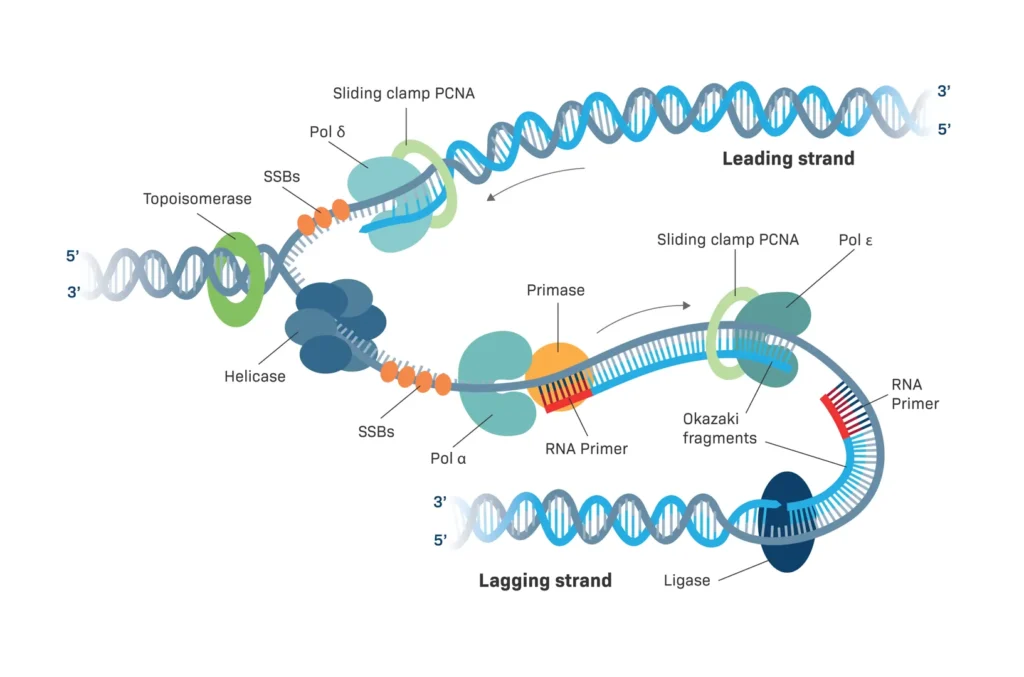
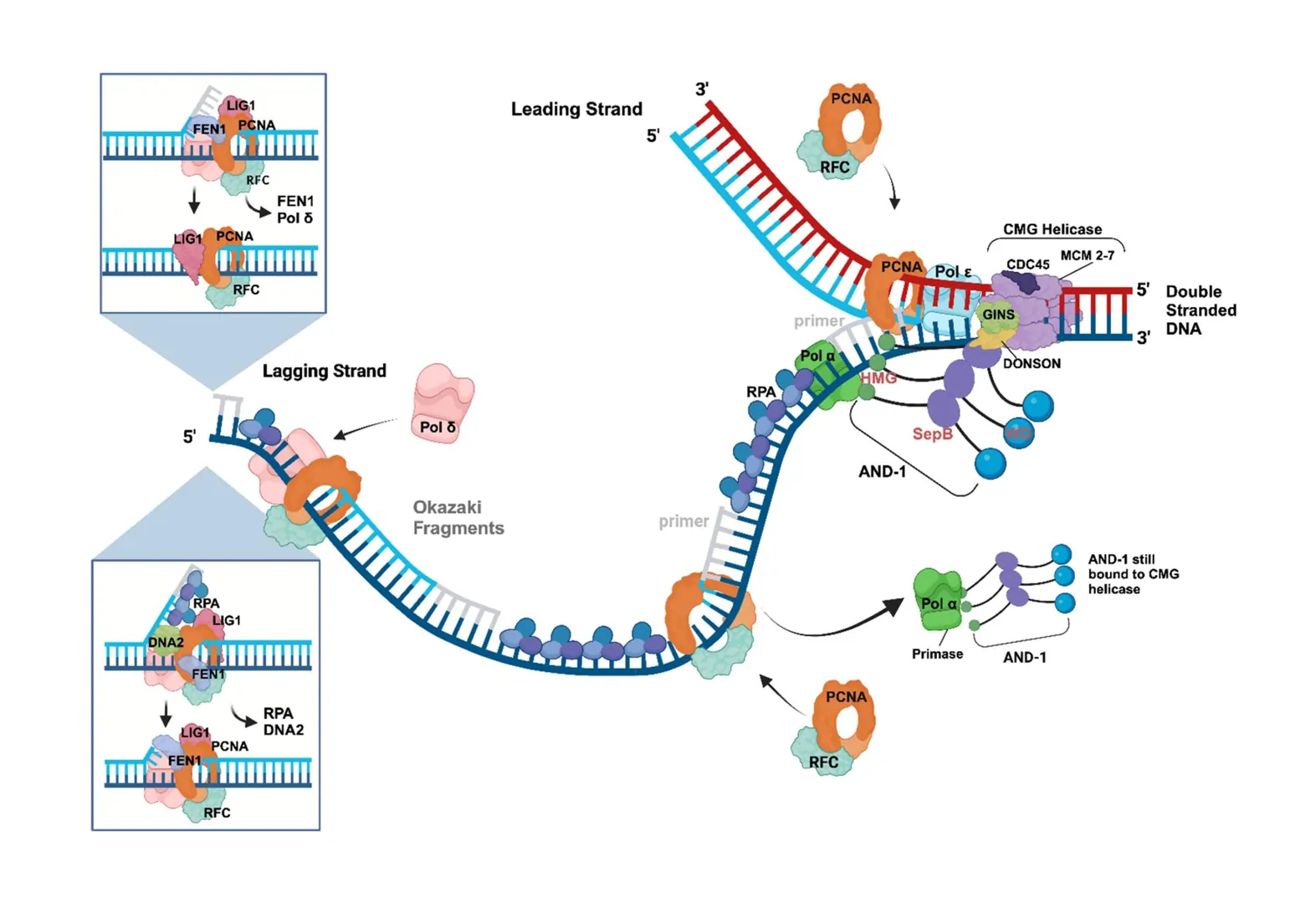
Initiation starts at the origin of replication, where helicase unwinds the helix, forming replication forks. Topoisomerase relieves tension, and primase lays RNA primers.
During elongation, DNA polymerase III adds nucleotides to the leading strand continuously and the lagging strand in Okazaki fragments. DNA polymerase I removes primers, and ligase seals gaps.
Termination happens when replication forks meet or at specific sequences.
This process ensures genetic continuity, with errors as low as 1 in 10 billion bases thanks to proofreading.
| Enzyme | Function | Stage Involved | Prokaryotic/Eukaryotic Note |
|---|---|---|---|
| Helicase | Unwinds DNA strands | Initiation | SSB proteins stabilize single strands |
| Topoisomerase | Relieves supercoiling | All stages | Type II cuts both strands |
| Primase | Synthesizes RNA primers | Initiation/Elongation | Essential for lagging strand |
| DNA Polymerase III | Main synthesis enzyme | Elongation | High processivity with clamp |
| DNA Polymerase I | Removes primers, fills gaps | Elongation | Has exonuclease activity |
| Ligase | Joins Okazaki fragments | Termination | Uses ATP or NAD+ |
This table details the enzymatic orchestra behind replication.
The Multifaceted Functions of DNA in Biology
DNA’s primary function is storing genetic information, but it extends far beyond. It directs protein synthesis via transcription to mRNA and translation. Genes, segments of DNA, code for polypeptides; for example, the insulin gene produces the hormone regulating blood sugar.
DNA regulates cellular metabolism, responds to mutations, and enables evolution through variations. In epigenetics, modifications like methylation alter gene expression without changing the sequence.
Beyond basics, DNA influences traits like intelligence or disease risk, interacting with environment in phenomena like phenotypic plasticity.
- Advanced Functions:
- Cellular differentiation: DNA guides stem cells to become specialized.
- Immune response: V(D)J recombination in DNA creates antibody diversity.
- Aging: Telomere shortening in DNA ends links to cellular senescence.
Mitochondrial and Plastid DNA
Mitochondrial DNA (mtDNA) is a circular molecule inherited maternally, about 16,500 base pairs in humans, coding for 37 genes involved in energy production. It’s prone to mutations due to less repair, linking to diseases like mitochondrial myopathy.
Plastid DNA (ptDNA) in plants, also circular (120,000-160,000 bp), encodes photosynthesis genes. Both support the endosymbiotic theory, resembling bacterial genomes.
Transfers between organelles and nucleus occur, like mitochondrial-to-plastid DNA in monocots.
| Feature | Mitochondrial DNA | Plastid DNA |
|---|---|---|
| Shape | Circular | Circular |
| Size (bp) | ~16,500 (humans) | 120,000-160,000 |
| Inheritance | Maternal | Mostly maternal, some paternal |
| Genes | 37 (13 proteins, rRNAs, tRNAs) | ~100-120 (photosynthesis-related) |
| Location | Mitochondria | Chloroplasts/plastids |
| Mutation Rate | High | Moderate |
This table compares these extranuclear DNAs.
DNA in Viruses: Examples and Implications
Many viruses use DNA as genetic material. Herpesviruses (dsDNA) cause lifelong infections, like varicella-zoster (chickenpox). Adenoviruses lead to respiratory illnesses.
Single-stranded DNA viruses, like parvoviruses, affect animals and humans. Plant DNA viruses, such as geminiviruses, damage crops.
These viruses hijack host machinery, providing models for studying DNA replication.
- Notable DNA Viruses:
- Poxviruses: Cause smallpox, now eradicated.
- Papillomaviruses: Linked to cervical cancer.
- Hepatitis B: Chronic liver disease.
| Virus Family | Genome Type | Examples | Diseases Caused |
|---|---|---|---|
| Herpesviridae | dsDNA | Herpes simplex, Varicella-zoster | Cold sores, chickenpox, shingles |
| Adenoviridae | dsDNA | Adenovirus | Respiratory infections, conjunctivitis |
| Papillomaviridae | dsDNA | Human papillomavirus | Warts, cervical cancer |
| Poxviridae | dsDNA | Vaccinia virus | Smallpox (historical) |
| Parvoviridae | ssDNA | Parvovirus B19 | Fifth disease, anemia |
Applications of DNA Technology
DNA technology has revolutionized society. Gene therapy inserts healthy genes to treat disorders like cystic fibrosis, using viral vectors.
DNA fingerprinting, developed by Alec Jeffreys in 1984, analyzes variable number tandem repeats (VNTRs) for identification in forensics and paternity tests. It’s solved countless cases, like exonerating innocents via the Innocence Project.
In agriculture, transgenic crops resist pests; in medicine, recombinant insulin is produced via bacteria.
- Key Applications:
- Forensics: Matching crime scene DNA.
- Medicine: Personalized treatments based on genetic profiles.
- Conservation: Identifying endangered species.
| Application | Description | Examples | Impact |
|---|---|---|---|
| Gene Therapy | Correcting defective genes | CRISPR for sickle cell | Potential cures for genetic diseases |
| DNA Fingerprinting | Unique genetic profiling | Paternity tests, crime solving | Legal and familial resolutions |
| Recombinant Drugs | Producing proteins in hosts | Insulin, vaccines | Affordable treatments |
| Agricultural Biotech | Modifying crops/animals | Bt cotton, golden rice | Increased yields, nutrition |
| Environmental Cleanup | Engineered microbes | Oil-degrading bacteria | Bioremediation |
Conclusion
DNA remains the cornerstone of biology, bridging past discoveries with future innovations. From Miescher’s initial isolation to today’s gene-editing tools, our understanding has grown exponentially. As we tackle challenges like climate change and pandemics, DNA technology offers hope through sustainable solutions and precision medicine. Embracing this knowledge empowers us to appreciate life’s complexity and harness it responsibly.
Read These Articles in Detail
- The Cell: The Fundamental Building Block of Life
- Prokaryotic Cells vs. Eukaryotic Cells: A Detailed Exploration
- Prokaryotic Cells: Definition, Anatomy, Functions, and Their Importance
- Eukaryotic Cells Explained: Definition, Structure, Functions, and Importance
- The Cell Membrane: Structure, Functions, and Evolutionary Significance
- The Cell Wall: Structure, Composition, Functions, and Evolutionary Significance
- Endomembrane System: A Detailed Exploration of the Cellular Machinery of Life
- Mitochondria: A Comprehensive Guide to Their Structure and Functions
- The Cell Envelope: The Protective Shield of Prokaryotic Cells
- Ribosomes: Definition, Structure, and Functions
- Endoplasmic Reticulum: Structure, Types, and Functions Explained
- The Golgi Apparatus: Structure, Functions, and Cellular Importance
- Cytoplasm and Nucleus: Structure, Functions, Differences, and Examples
- What Is Cell Signaling? Structure, Types, and Functions Explained
- Three Main Parts of a Nucleotide: Structure and Functions
- Enzymes: Definition, Structure, Classification, and Functions
- DNA: Structure, Function, Discovery, and Modern Applications
- DNA Replication: Steps, Process, and Genetic Importance
- Properties of DNA: Structure, Physical, and Chemical Characteristics
- DNA Packaging: How DNA Fits into the Nucleus of a Cell
- R-Factors and Plasmids: How Bacteria Develop Antibiotic Resistance
- Chromosomes: Structure, Types, Functions, and Role in Genetics
- Genetic Material: DNA, RNA, and Their Role in Heredity and Evolution
- Deoxyribose and Ribose: Structure and Function in DNA and RNA
- Differences Between Genes and DNA: Definitions, Structures, and Functions
- RNA: Definition, Structure, Types, Functions, and Its Role in Life
Frequently Asked Questions
FAQ 1: What is DNA and its role in heredity?
DNA, short for deoxyribonucleic acid, is a remarkable molecule that acts as the blueprint for life in nearly all organisms on Earth. It’s found in the cells of humans, animals, plants, and even some viruses, carrying the genetic instructions needed for growth, development, and reproduction. At its core, DNA is made up of smaller units called nucleotides, each containing a sugar molecule, a phosphate group, and one of four nitrogenous bases: adenine, thymine, guanine, or cytosine. These bases form the code that tells cells how to build proteins and perform vital functions. This genetic material is packaged into structures called chromosomes within the cell nucleus, ensuring it’s protected and organized.
The role of DNA in heredity is fundamental, as it passes traits from parents to offspring through generations. When organisms reproduce, DNA is copied and transmitted, allowing children to inherit characteristics like eye color, height, or susceptibility to certain diseases. In humans, for example, half of the DNA comes from the mother and half from the father, creating a unique combination that defines individuality. This process of inheritance isn’t just about physical traits; it also influences behavior and health predispositions, making DNA the key to understanding family lineages and evolutionary history.
Beyond basic inheritance, DNA’s hereditary function involves complex interactions with the environment. Genes, which are segments of DNA, can be turned on or off in response to factors like diet or stress, affecting how traits are expressed. For instance, identical twins share the same DNA but may develop differences due to lifestyle variations. This highlights DNA’s dynamic nature in heredity, not just as a static code but as a responsive system that adapts to ensure survival and diversity in species.
In viruses, DNA can also serve as the genetic material, though some use RNA instead. When a DNA virus infects a host, it integrates its genetic code into the cell’s machinery, hijacking it to replicate and spread. This demonstrates how DNA’s role in heredity extends beyond traditional organisms, influencing even microscopic entities and their evolution over time.
FAQ 2: Who discovered the structure of DNA?
The discovery of DNA’s structure is a story of scientific collaboration and perseverance spanning several decades. It began in 1869 when Swiss biologist Friedrich Miescher first isolated a substance he called nuclein from white blood cells, which we now know as DNA. Miescher’s work laid the foundation, but at the time, the significance of this molecule wasn’t fully understood, as scientists believed proteins were the carriers of genetic information.
In the early 20th century, researchers like Phoebus Levene advanced the field by identifying DNA’s basic components, including its nucleotides. However, it was Oswald Avery’s experiments in the 1940s that proved DNA, not proteins, was the hereditary material, shifting focus to its role in genetics. These findings set the stage for the breakthrough in 1953, when James Watson and Francis Crick proposed the double-helix model of DNA.
Crucial to Watson and Crick’s model was the X-ray diffraction work of Rosalind Franklin and Maurice Wilkins. Franklin’s Photo 51 provided key evidence of the helical structure, though her contributions were underrecognized during her lifetime due to societal biases. Watson, Crick, and Wilkins received the Nobel Prize in 1962, but Franklin had passed away by then, highlighting ongoing discussions about credit in scientific discoveries.
Later advancements, like Frederick Sanger’s DNA sequencing in the 1970s, built on this foundation, enabling modern genomics. The history of DNA discovery underscores the importance of interdisciplinary efforts, from chemistry to biology, in unraveling life’s mysteries.
FAQ 3: What is the double helix structure of DNA?
The double helix structure of DNA resembles a twisted ladder, where two strands wind around each other in a spiral formation. Each strand consists of a sugar-phosphate backbone, with nitrogenous bases forming the rungs through hydrogen bonds: adenine pairs with thymine, and guanine with cytosine. This complementary base pairing ensures stability and allows for accurate replication.
The strands are antiparallel, meaning one runs from 5′ to 3′ while the other goes 3′ to 5′, contributing to the molecule’s functionality. The helix completes a turn every 10 base pairs, with major and minor grooves that proteins can access for processes like transcription.
This structure explains how DNA stores vast amounts of information compactly, coiling into chromosomes within cells. In humans, if uncoiled, DNA from one cell would stretch about two meters, yet it fits into a tiny nucleus.
The double helix’s design facilitates repair and mutation, driving evolution. Its discovery revolutionized biology, enabling advancements in genetic engineering and medicine.
FAQ 4: What are the different types of DNA conformations like A-DNA, B-DNA, and Z-DNA?
DNA can adopt various conformations depending on environmental conditions, with B-DNA being the most common under normal cellular settings. B-DNA is a right-handed helix with about 10.5 base pairs per turn, featuring wide major grooves and narrow minor ones, ideal for transcription and replication.
A-DNA forms in low-humidity environments, appearing shorter and wider with a deep minor groove. It’s protective during dehydration and seen in RNA-DNA hybrids.
Z-DNA, a left-handed helix, emerges in high-salt conditions or alternating purine-pyrimidine sequences, potentially regulating genes. Its zigzag shape may relieve stress during cellular processes.
These forms showcase DNA’s flexibility, influencing interactions with proteins and overall genome function. Understanding them aids in studying diseases linked to structural changes.
FAQ 5: What are Chargaff’s rules and why are they important?
Chargaff’s rules, discovered by Erwin Chargaff, state that in DNA, adenine equals thymine, and guanine equals cytosine in quantity. This parity reflects complementary base pairing.
These rules were pivotal for Watson and Crick’s double-helix model, confirming the structure’s logic. They ensure replication fidelity, as each strand templates the other.
Importance extends to evolutionary studies, where base ratios vary by species but maintain parity. Deviations can signal mutations or viral DNA.
In modern genomics, Chargaff’s rules aid sequence analysis and synthetic biology. They remain foundational in understanding genetic stability.
FAQ 6: How does DNA replication work?
DNA replication is a semi-conservative process occurring during cell division’s S phase, ensuring genetic continuity. It starts with initiation at origins, where helicase unwinds the helix, forming forks.
Elongation involves DNA polymerase adding nucleotides: continuously on the leading strand, discontinuously on the lagging via Okazaki fragments. Primers and ligase seal gaps.
Termination occurs when forks meet or at specific sites, with proofreading minimizing errors.
This mechanism supports life by duplicating the genome accurately for daughter cells. Disruptions can lead to diseases like cancer.
FAQ 7: What are the main functions of DNA in living organisms?
DNA stores genetic information, directing protein synthesis through transcription and translation. Genes code for proteins essential to structure and function.
It regulates cellular processes, with epigenetics modifying expression without altering sequences.
DNA enables reproduction and heredity, passing traits to offspring. Mutations introduce variation, driving evolution.
In metabolism, DNA influences enzyme production for energy and growth. Its functions underpin all life processes.
FAQ 8: What is mitochondrial DNA and why is it significant?
Mitochondrial DNA (mtDNA) is a circular molecule in cell mitochondria, inherited maternally and encoding 37 genes for energy production.
Its significance lies in tracing maternal ancestry and studying evolution. High mutation rates link to diseases like myopathies.
mtDNA supports the endosymbiotic theory, resembling bacterial genomes.
In forensics and medicine, it’s used for identification and diagnosing disorders. Its role in aging and neurodegeneration is under research.
FAQ 9: How do DNA viruses function and what are some examples?
DNA viruses replicate by injecting their genome into host cells, using cellular machinery to transcribe and replicate. They can be double-stranded or single-stranded.
Examples include herpesviruses causing cold sores and chickenpox. Papillomaviruses lead to warts and cancers.
Hepatitis B, a partially double-stranded virus, affects the liver.
These viruses integrate into host DNA, persisting and causing chronic issues. Understanding them aids vaccine development.
FAQ 10: What are modern applications of DNA technology in medicine and forensics?
In medicine, DNA technology enables gene therapy, correcting defective genes for conditions like cystic fibrosis. CRISPR edits genomes precisely.
Pharmacogenomics tailors drugs based on genetic profiles, improving efficacy.
In forensics, DNA profiling identifies individuals from samples, solving crimes and paternity cases. Next-generation sequencing enhances accuracy.
These applications also include recombinant proteins like insulin. Ethical considerations ensure responsible use.
FAQ 11: What is the difference between DNA and RNA?
DNA and RNA are both essential nucleic acids that play critical roles in the storage and expression of genetic information, but they differ in several key ways that influence their functions within cells. DNA, or deoxyribonucleic acid, is primarily responsible for storing long-term genetic data, acting as the blueprint for an organism’s traits and development. It’s a double-stranded molecule, forming a stable double helix structure that protects the genetic code from damage and allows for accurate replication during cell division. In contrast, RNA, or ribonucleic acid, is usually single-stranded and more versatile, serving as a messenger that carries instructions from DNA to the protein synthesis machinery in the cell.
One of the primary structural differences lies in their sugar components: DNA contains deoxyribose, a sugar lacking an oxygen atom at the 2′ position, which makes it more stable and less prone to degradation. RNA, however, has ribose, which includes that extra oxygen, rendering it more reactive and suitable for short-term roles like transcription. Additionally, the nitrogenous bases vary slightly; both share adenine, guanine, and cytosine, but DNA uses thymine while RNA substitutes it with uracil, which can form hydrogen bonds similarly but allows RNA to fold into complex shapes for functions like catalysis in ribozymes.
Location within the cell also sets them apart, with DNA residing mostly in the nucleus of eukaryotic cells, tightly packed into chromosomes, and a small amount in mitochondria or plastids. RNA, on the other hand, is synthesized in the nucleus but travels to the cytoplasm, where it participates in protein production via ribosomes. This mobility enables RNA to act as an intermediary, translating the stable genetic code of DNA into functional proteins that carry out cellular tasks.
Functionally, DNA’s stability makes it ideal for heredity, passing genetic information across generations with high fidelity, while RNA’s flexibility supports dynamic processes like gene expression regulation and viral replication in some organisms. For example, in retroviruses like HIV, RNA is reverse-transcribed into DNA, illustrating how these molecules can interact in complex biological systems. Understanding these differences not only clarifies basic biology but also underpins advancements in biotechnology, such as mRNA vaccines that leverage RNA’s transient nature to instruct cells to produce immune responses without altering the permanent DNA code.
FAQ 12: What causes DNA mutations and what are their effects?
DNA mutations are changes in the sequence of nucleotides that can alter genetic information, and they arise from various sources both internal and external to the cell. Spontaneous mutations often occur during DNA replication when errors slip past proofreading mechanisms, such as mismatched base pairs or slippage in repetitive sequences. These natural mishaps are relatively rare but accumulate over time, contributing to genetic diversity.
External factors, known as mutagens, significantly increase mutation rates by damaging DNA structure. Chemical agents like those in tobacco smoke or certain pesticides can add alkyl groups to bases, leading to mispairing, while radiation from UV light or X-rays can create thymine dimers or break strands entirely. Even some viruses integrate their genetic material, causing insertions that disrupt normal genes.
The effects of mutations vary widely, ranging from neutral to beneficial or harmful, depending on their location and type. Point mutations might change a single amino acid in a protein, sometimes with no noticeable impact, but in critical regions, they can lead to diseases like sickle cell anemia.
- Beneficial effects: Some mutations confer advantages, such as antibiotic resistance in bacteria or lactose tolerance in humans, driving evolution.
- Neutral effects: Many occur in non-coding regions, like introns, without affecting protein function or organism fitness.
- Harmful effects: Frameshift mutations from insertions or deletions can scramble entire protein sequences, potentially causing genetic disorders like cystic fibrosis.
- Cancer links: Accumulating mutations in oncogenes or tumor suppressors can lead to uncontrolled cell growth, as seen in various cancers.
- Aging implications: Over a lifetime, mutations contribute to cellular dysfunction, linking to age-related conditions like neurodegeneration.
Repair systems like mismatch repair or nucleotide excision help mitigate these effects, but when overwhelmed, mutations can lead to heritable diseases or evolutionary changes. Research into mutation dynamics continues to inform treatments, such as targeted therapies that exploit specific cancer-causing alterations.
FAQ 13: What was the Human Genome Project and its impact?
The Human Genome Project was a monumental international effort launched in 1990 to map and sequence the entire human genome, providing a comprehensive reference for the approximately 3 billion base pairs that make up our DNA. Completed ahead of schedule in 2003, it involved thousands of scientists and revolutionized our understanding of genetics.
| Aspect | Description | Key Achievements | Long-Term Impact |
|---|---|---|---|
| Goals | To identify all human genes, determine the sequence of DNA bases, and make data publicly available. | Sequenced 92% of the genome initially, with full completion in 2022; identified about 20,000-25,000 genes. | Accelerated personalized medicine and gene therapy developments. |
| Methods | Used Sanger sequencing and hierarchical shotgun approaches; involved cloning DNA fragments into bacteria. | Cost reduced from billions to about $100 million by end; fostered bioinformatics tools. | Paved way for next-generation sequencing, dropping costs to under $1,000 per genome. |
| Collaborators | Led by U.S. Department of Energy and National Institutes of Health, with global partners like the Wellcome Trust. | Public-private competition with Celera Genomics spurred faster progress. | Enhanced international scientific cooperation and ethical discussions on genomics. |
| Discoveries | Revealed humans share 99.9% DNA similarity; fewer genes than expected, emphasizing regulatory elements. | Uncovered variations like SNPs linked to diseases. | Informed research on complex traits, from cancer to Alzheimer’s, enabling targeted drugs. |
| Ethical Considerations | Addressed privacy, discrimination, and access issues through ELSI program. | Led to laws like GINA in the U.S. protecting against genetic discrimination. | Shaped policies for genomic data sharing and equity in research benefits. |
| Applications | Basis for genome-wide association studies and CRISPR editing. | Enabled identification of disease-causing mutations. | Transformed diagnostics, pharmacogenomics, and evolutionary biology studies. |
This project not only decoded our genetic blueprint but also sparked a genomics era, influencing fields from agriculture to forensics.
FAQ 14: How does DNA paternity testing work?
DNA paternity testing is a reliable scientific method used to determine biological relationships, typically between a child and an alleged father, by comparing genetic markers in their DNA samples. The process begins with sample collection, most commonly through buccal swabs that gently rub the inside of the cheek to gather cells containing DNA. This non-invasive approach is preferred for its simplicity and accuracy, though blood samples or prenatal methods like amniocentesis can be used in specific cases.
Once collected, samples are sent to a laboratory where DNA is extracted and amplified using polymerase chain reaction (PCR) to produce enough material for analysis. Technicians focus on short tandem repeats (STRs), repetitive DNA sequences that vary greatly among individuals, providing a unique genetic fingerprint. By examining 15-20 such loci, the lab calculates the probability of paternity, often exceeding 99.99% for inclusions.
Including the mother’s sample enhances accuracy by accounting for her genetic contribution, but it’s not always necessary. Results are presented in a report showing allele matches; if the alleged father shares alleles at every locus, he’s likely the biological parent. Exclusions are definitive if mismatches occur at multiple sites.
Legal tests follow chain-of-custody protocols with witnessed collections and ID verification, while at-home kits offer privacy but lack court admissibility. Advances like non-invasive prenatal paternity tests analyze fetal DNA in maternal blood from week eight, expanding options for early confirmation.
FAQ 15: What are telomeres and how do they relate to aging?
Telomeres are protective caps at the ends of chromosomes, composed of repetitive DNA sequences and associated proteins, that safeguard genetic material during cell division. They prevent chromosomes from fraying or fusing, much like plastic tips on shoelaces, but shorten with each replication due to the end-replication problem.
As cells divide, telomere attrition accumulates, eventually triggering cellular senescence where cells stop dividing, contributing to tissue aging and dysfunction. This process links to age-related diseases, as short telomeres correlate with conditions like cardiovascular issues and diabetes.
- Enzyme involvement: Telomerase adds repeats to telomeres, but it’s inactive in most somatic cells, leading to progressive shortening; active in stem and cancer cells for immortality.
- Lifestyle factors: Stress, poor diet, and smoking accelerate shortening, while exercise and antioxidants may preserve length.
- Disease associations: Premature shortening causes progeroid syndromes; elongated telomeres might increase cancer risk by allowing unchecked growth.
- Therapeutic potential: Research explores telomerase activation for anti-aging, but risks include tumorigenesis; inhibitors target cancer cells.
- Evolutionary role: Telomere dynamics balance longevity and cancer prevention, influencing species lifespan variations.
Ongoing studies aim to manipulate telomeres for healthier aging, highlighting their pivotal role in the biology of senescence.
FAQ 16: What is epigenetics and how does it relate to DNA?
Epigenetics refers to heritable changes in gene expression that occur without altering the underlying DNA sequence, essentially acting as a regulatory layer on top of the genetic code. These modifications influence which genes are active or silenced in different cells or under varying conditions, allowing for cellular diversity despite identical DNA in most body cells.
Key mechanisms include DNA methylation, where methyl groups attach to cytosine bases, often repressing gene activity, and histone modifications that alter chromatin structure to make DNA more or less accessible to transcription machinery. Non-coding RNAs also play a role by targeting specific genes for silencing. Unlike mutations, these changes are reversible, responding to environmental cues like nutrition or stress.
In relation to DNA, epigenetics doesn’t change the sequence but modulates its readout, explaining why identical twins can develop different traits over time. For instance, early-life experiences can imprint epigenetic marks that affect health later, linking environment to gene function without genetic alteration.
This field has profound implications for disease, as aberrant epigenetic patterns contribute to cancer, where tumor suppressors are hypermethylated, or neurological disorders influenced by imprinted genes. Therapeutic strategies, like HDAC inhibitors, target these modifications to restore normal expression, showcasing epigenetics’ potential in precision medicine.
FAQ 17: What are plasmids and their applications in biotechnology?
Plasmids are small, circular DNA molecules found in bacteria and some eukaryotes, separate from chromosomal DNA, that can replicate independently and often carry genes for advantageous traits like antibiotic resistance. In biotechnology, they’re engineered as vectors for gene manipulation.
| Feature | Description | Biotechnology Applications | Examples |
|---|---|---|---|
| Structure | Double-stranded, circular, 1-200 kb size; contains origin of replication, selectable markers. | Cloning vectors for inserting foreign DNA. | pBR322 for basic cloning; pUC series for high-copy expression. |
| Replication | Autonomous, with multiple copies per cell; controlled by ori sites. | Produces large quantities of recombinant DNA. | Protein production like insulin in E. coli. |
| Transfer | Conjugative plasmids spread via pili; non-conjugative need lab methods. | Gene delivery in genetic engineering. | Agrobacterium tumefaciens plasmids for plant transformation. |
| Modifications | Engineered with restriction sites, promoters, reporters. | CRISPR delivery, vaccine development. | mRNA vaccine precursors; gene therapy vectors. |
| Safety/Regulation | Designed with safeguards against unintended spread. | Therapeutic manufacturing under GMP. | Plasmid-based COVID-19 vaccines; bioremediation enzymes. |
| Challenges | Stability issues, host specificity. | Optimized for industrial scales. | High-yield strains for pharmaceuticals. |
Plasmids continue to drive innovations in synthetic biology and therapeutics.
FAQ 18: What are the main methods of DNA sequencing?
DNA sequencing determines the precise order of nucleotides in a DNA molecule, enabling insights into genomes, and has evolved from labor-intensive techniques to high-throughput technologies. Early methods laid the foundation, while modern ones handle massive data volumes.
Sanger sequencing, the classic chain-termination approach, uses dideoxynucleotides to halt extension at specific bases, generating fragments separated by electrophoresis for readout. It’s accurate for short reads but time-consuming for large genomes.
Next-generation sequencing (NGS) revolutionized the field with parallel processing, including platforms like Illumina’s sequencing-by-synthesis, where fluorescent nucleotides are added and imaged in cycles.
- Pyrosequencing: Detects pyrophosphate release during nucleotide incorporation, used in 454 technology for longer reads.
- Ion semiconductor: Measures pH changes from hydrogen ions during synthesis, as in Ion Torrent systems.
- Single-molecule real-time (SMRT): PacBio’s method watches polymerase in real-time with zero-mode waveguides for long reads.
- Nanopore sequencing: Oxford Nanopore passes DNA through pores, detecting electrical changes for ultra-long reads.
- Emerging techniques: Include sequencing by hybridization on arrays or mass spectrometry for rapid analysis.
These methods support applications from clinical diagnostics to evolutionary studies, with choices based on read length, accuracy, and cost.
FAQ 19: What is recombinant DNA technology?
Recombinant DNA technology involves combining DNA from different sources to create novel sequences, enabling the production of proteins or organisms with desired traits. It starts with isolating target genes using restriction enzymes that cut DNA at specific sites, allowing insertion into vectors like plasmids.
The recombinant molecule is then introduced into host cells, such as bacteria or yeast, where it replicates and expresses the foreign gene. This process, pioneered in the 1970s, has produced therapeutics like human insulin for diabetes, bypassing animal sources.
Applications span medicine, agriculture, and industry; for instance, genetically modified crops resist pests or herbicides, improving yields. In research, it facilitates gene function studies through knockout models or fluorescent tagging.
Ethical concerns include biosafety and ecological impacts, addressed by regulations ensuring contained use. Future integrations with CRISPR enhance precision, promising cures for genetic disorders.
FAQ 20: What are the future prospects of DNA research?
DNA research is poised for transformative advances, building on genomics to tackle global challenges in health, environment, and technology. With sequencing costs plummeting, widespread genomic screening could become routine.
| Area | Current Trends | Future Prospects | Potential Challenges |
|---|---|---|---|
| Personalized Medicine | AI-integrated analysis for drug responses. | Tailored therapies based on individual genomes by 2030. | Data privacy and equitable access. |
| Gene Editing | CRISPR trials for sickle cell and more. | Cures for inherited diseases; designer crops for climate resilience. | Off-target effects and ethical debates. |
| Synthetic Genomics | Building minimal genomes. | Custom organisms for biofuels or pharmaceuticals. | Biosecurity risks. |
| Ancient DNA | Sequencing extinct species. | Insights into human evolution; de-extinction possibilities. | Sample degradation and contamination. |
| Data Integration | Multi-omics with epigenetics. | Predictive models for aging and disease prevention. | Computational demands and interdisciplinary gaps. |
| Global Initiatives | All of Us program expansions. | Diverse genomic databases for inclusive research. | Funding and international collaboration. |
These developments promise a healthier future, emphasizing responsible innovation.
Acknowledgement
The Examsmeta.com Website would like to expresses its gratitude to the following reputable sources for providing valuable insights and comprehensive information that greatly enriched the article “DNA: Structure, Function, Discovery, and Modern Applications.” Their well-researched content and accessible data were instrumental in ensuring the article’s depth and accuracy, making complex scientific concepts understandable and engaging for readers.
- Nature (www.nature.com): For offering detailed resources on DNA structure, historical discoveries, and cutting-edge genetic research that shaped the article’s scientific foundation.
- ScienceDirect (www.sciencedirect.com): For providing peer-reviewed studies and in-depth articles on DNA replication, mutations, and biotechnological applications, enhancing the article’s credibility.
- National Human Genome Research Institute (www.genome.gov): For its authoritative information on the Human Genome Project and genomics, which informed the sections on modern applications and historical context.
- PubMed (pubmed.ncbi.nlm.nih.gov): For access to a vast repository of scientific literature that supported the article’s discussions on epigenetics, telomeres, and DNA sequencing advancements.
- Encyclopaedia Britannica (www.britannica.com): For its clear and concise explanations of DNA’s structure, function, and discovery, which helped simplify complex concepts for a broader audience.

